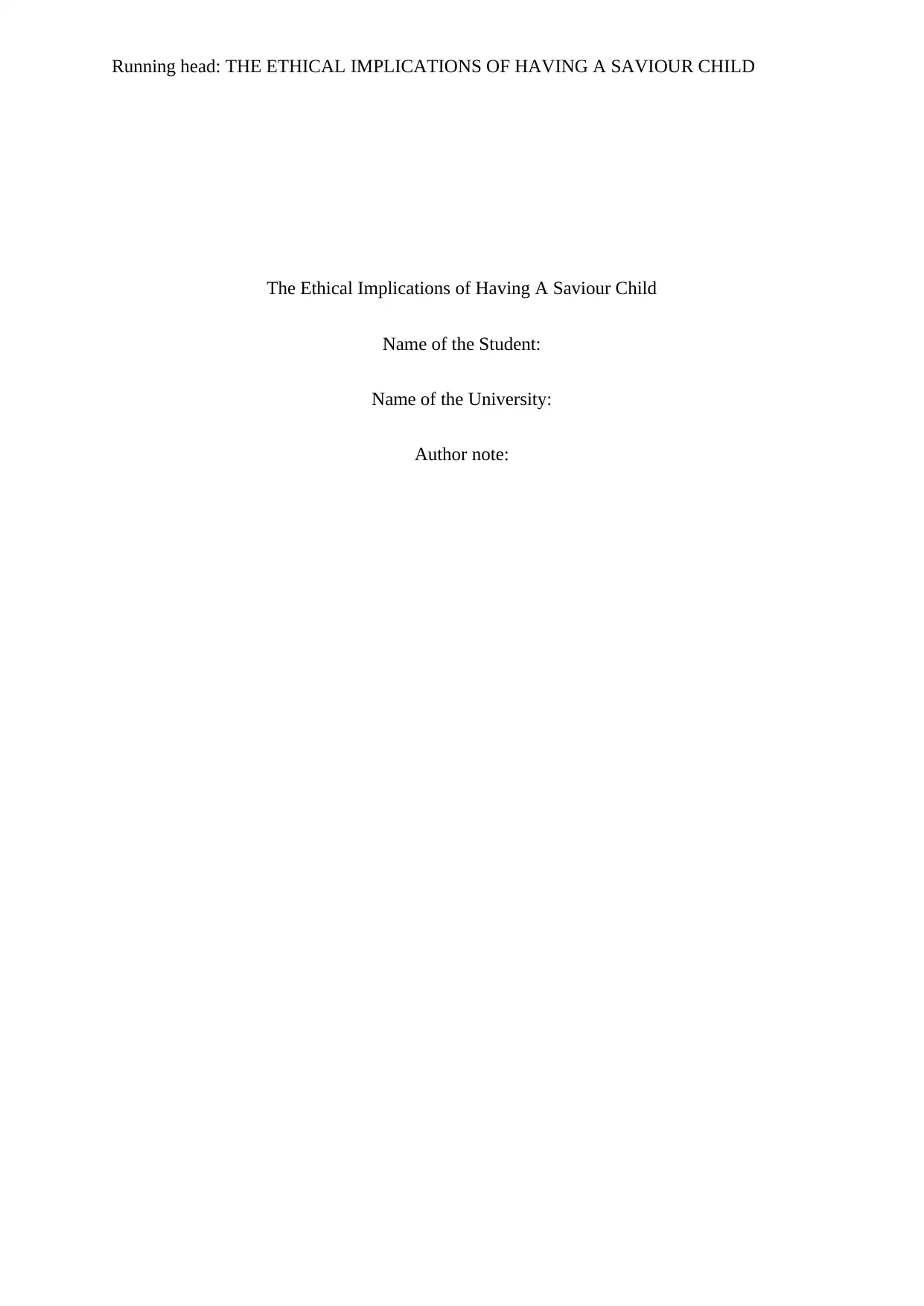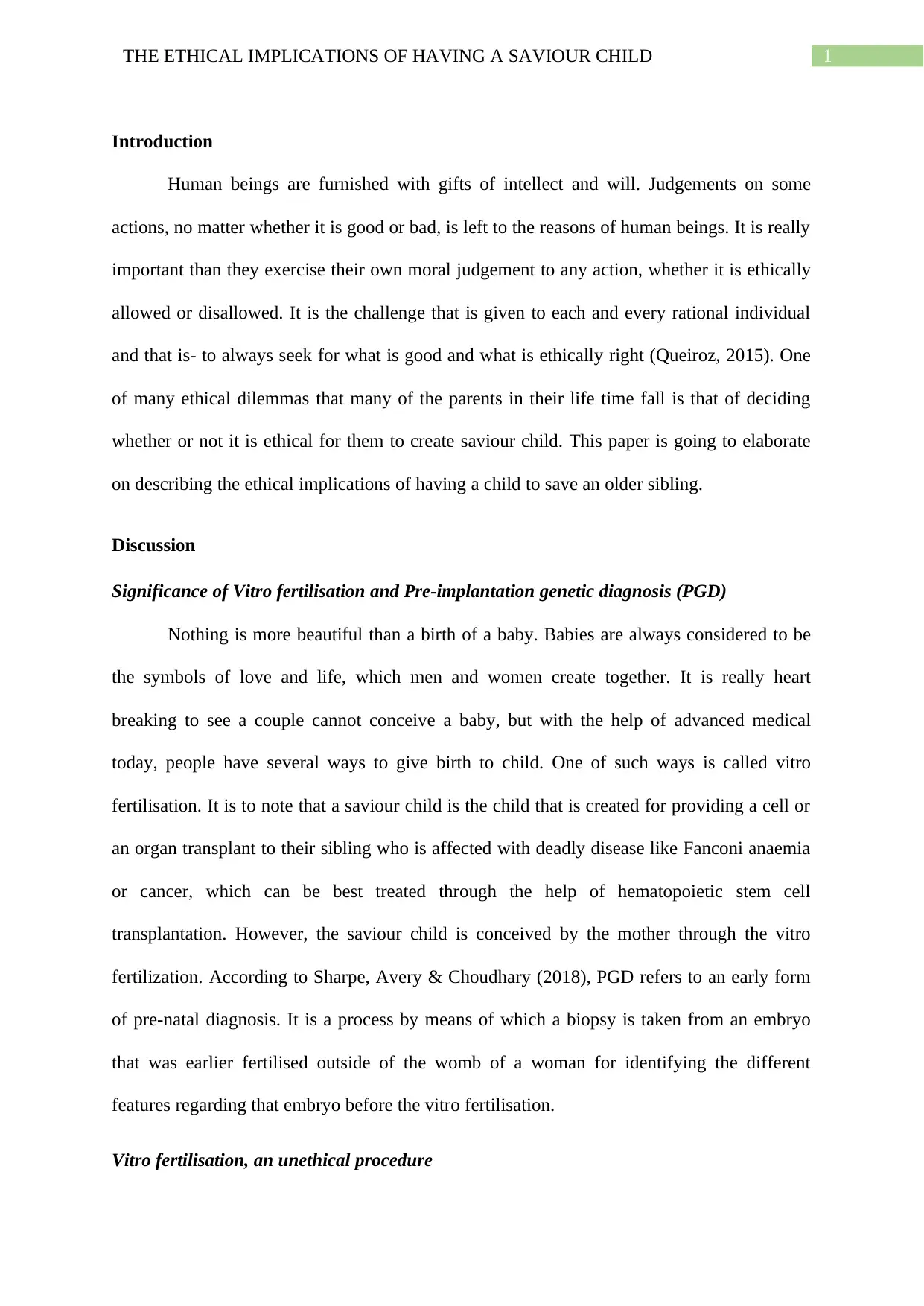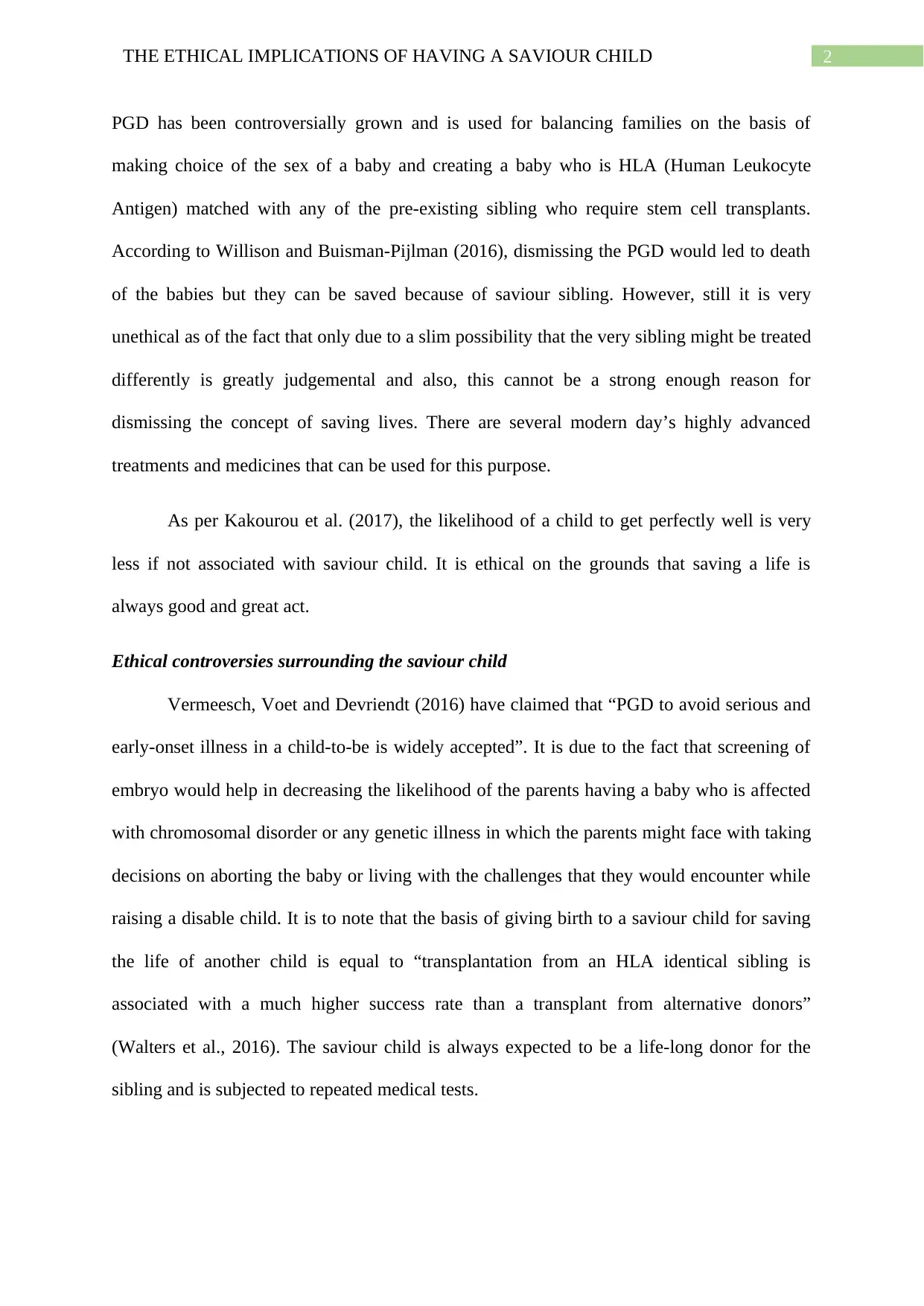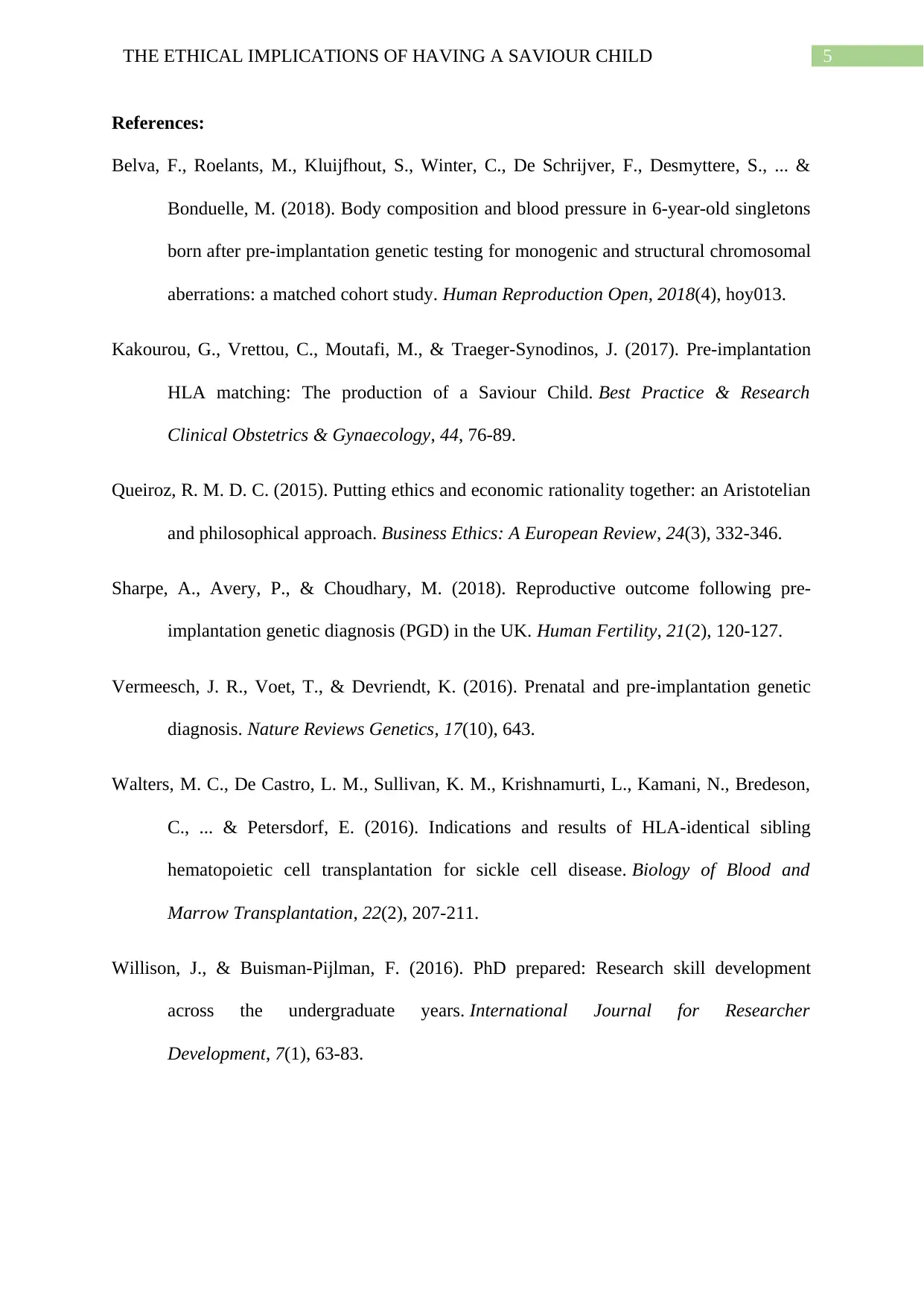The Ethical Implications of Having A Saviour Child
VerifiedAdded on 2023/04/22
|6
|1632
|485
AI Summary
This paper elaborates on describing the ethical implications of having a child to save an older sibling. It discusses the significance of Vitro fertilisation and Pre-implantation genetic diagnosis (PGD), ethical controversies surrounding the saviour child, and more.
Contribute Materials
Your contribution can guide someone’s learning journey. Share your
documents today.

Running head: THE ETHICAL IMPLICATIONS OF HAVING A SAVIOUR CHILD
The Ethical Implications of Having A Saviour Child
Name of the Student:
Name of the University:
Author note:
The Ethical Implications of Having A Saviour Child
Name of the Student:
Name of the University:
Author note:
Secure Best Marks with AI Grader
Need help grading? Try our AI Grader for instant feedback on your assignments.

1THE ETHICAL IMPLICATIONS OF HAVING A SAVIOUR CHILD
Introduction
Human beings are furnished with gifts of intellect and will. Judgements on some
actions, no matter whether it is good or bad, is left to the reasons of human beings. It is really
important than they exercise their own moral judgement to any action, whether it is ethically
allowed or disallowed. It is the challenge that is given to each and every rational individual
and that is- to always seek for what is good and what is ethically right (Queiroz, 2015). One
of many ethical dilemmas that many of the parents in their life time fall is that of deciding
whether or not it is ethical for them to create saviour child. This paper is going to elaborate
on describing the ethical implications of having a child to save an older sibling.
Discussion
Significance of Vitro fertilisation and Pre-implantation genetic diagnosis (PGD)
Nothing is more beautiful than a birth of a baby. Babies are always considered to be
the symbols of love and life, which men and women create together. It is really heart
breaking to see a couple cannot conceive a baby, but with the help of advanced medical
today, people have several ways to give birth to child. One of such ways is called vitro
fertilisation. It is to note that a saviour child is the child that is created for providing a cell or
an organ transplant to their sibling who is affected with deadly disease like Fanconi anaemia
or cancer, which can be best treated through the help of hematopoietic stem cell
transplantation. However, the saviour child is conceived by the mother through the vitro
fertilization. According to Sharpe, Avery & Choudhary (2018), PGD refers to an early form
of pre-natal diagnosis. It is a process by means of which a biopsy is taken from an embryo
that was earlier fertilised outside of the womb of a woman for identifying the different
features regarding that embryo before the vitro fertilisation.
Vitro fertilisation, an unethical procedure
Introduction
Human beings are furnished with gifts of intellect and will. Judgements on some
actions, no matter whether it is good or bad, is left to the reasons of human beings. It is really
important than they exercise their own moral judgement to any action, whether it is ethically
allowed or disallowed. It is the challenge that is given to each and every rational individual
and that is- to always seek for what is good and what is ethically right (Queiroz, 2015). One
of many ethical dilemmas that many of the parents in their life time fall is that of deciding
whether or not it is ethical for them to create saviour child. This paper is going to elaborate
on describing the ethical implications of having a child to save an older sibling.
Discussion
Significance of Vitro fertilisation and Pre-implantation genetic diagnosis (PGD)
Nothing is more beautiful than a birth of a baby. Babies are always considered to be
the symbols of love and life, which men and women create together. It is really heart
breaking to see a couple cannot conceive a baby, but with the help of advanced medical
today, people have several ways to give birth to child. One of such ways is called vitro
fertilisation. It is to note that a saviour child is the child that is created for providing a cell or
an organ transplant to their sibling who is affected with deadly disease like Fanconi anaemia
or cancer, which can be best treated through the help of hematopoietic stem cell
transplantation. However, the saviour child is conceived by the mother through the vitro
fertilization. According to Sharpe, Avery & Choudhary (2018), PGD refers to an early form
of pre-natal diagnosis. It is a process by means of which a biopsy is taken from an embryo
that was earlier fertilised outside of the womb of a woman for identifying the different
features regarding that embryo before the vitro fertilisation.
Vitro fertilisation, an unethical procedure

2THE ETHICAL IMPLICATIONS OF HAVING A SAVIOUR CHILD
PGD has been controversially grown and is used for balancing families on the basis of
making choice of the sex of a baby and creating a baby who is HLA (Human Leukocyte
Antigen) matched with any of the pre-existing sibling who require stem cell transplants.
According to Willison and Buisman-Pijlman (2016), dismissing the PGD would led to death
of the babies but they can be saved because of saviour sibling. However, still it is very
unethical as of the fact that only due to a slim possibility that the very sibling might be treated
differently is greatly judgemental and also, this cannot be a strong enough reason for
dismissing the concept of saving lives. There are several modern day’s highly advanced
treatments and medicines that can be used for this purpose.
As per Kakourou et al. (2017), the likelihood of a child to get perfectly well is very
less if not associated with saviour child. It is ethical on the grounds that saving a life is
always good and great act.
Ethical controversies surrounding the saviour child
Vermeesch, Voet and Devriendt (2016) have claimed that “PGD to avoid serious and
early-onset illness in a child-to-be is widely accepted”. It is due to the fact that screening of
embryo would help in decreasing the likelihood of the parents having a baby who is affected
with chromosomal disorder or any genetic illness in which the parents might face with taking
decisions on aborting the baby or living with the challenges that they would encounter while
raising a disable child. It is to note that the basis of giving birth to a saviour child for saving
the life of another child is equal to “transplantation from an HLA identical sibling is
associated with a much higher success rate than a transplant from alternative donors”
(Walters et al., 2016). The saviour child is always expected to be a life-long donor for the
sibling and is subjected to repeated medical tests.
PGD has been controversially grown and is used for balancing families on the basis of
making choice of the sex of a baby and creating a baby who is HLA (Human Leukocyte
Antigen) matched with any of the pre-existing sibling who require stem cell transplants.
According to Willison and Buisman-Pijlman (2016), dismissing the PGD would led to death
of the babies but they can be saved because of saviour sibling. However, still it is very
unethical as of the fact that only due to a slim possibility that the very sibling might be treated
differently is greatly judgemental and also, this cannot be a strong enough reason for
dismissing the concept of saving lives. There are several modern day’s highly advanced
treatments and medicines that can be used for this purpose.
As per Kakourou et al. (2017), the likelihood of a child to get perfectly well is very
less if not associated with saviour child. It is ethical on the grounds that saving a life is
always good and great act.
Ethical controversies surrounding the saviour child
Vermeesch, Voet and Devriendt (2016) have claimed that “PGD to avoid serious and
early-onset illness in a child-to-be is widely accepted”. It is due to the fact that screening of
embryo would help in decreasing the likelihood of the parents having a baby who is affected
with chromosomal disorder or any genetic illness in which the parents might face with taking
decisions on aborting the baby or living with the challenges that they would encounter while
raising a disable child. It is to note that the basis of giving birth to a saviour child for saving
the life of another child is equal to “transplantation from an HLA identical sibling is
associated with a much higher success rate than a transplant from alternative donors”
(Walters et al., 2016). The saviour child is always expected to be a life-long donor for the
sibling and is subjected to repeated medical tests.

3THE ETHICAL IMPLICATIONS OF HAVING A SAVIOUR CHILD
There are several researchers who think that Saviour child is all about just conceiving
a baby as an instrument for curing another child. In contemporary world, parents have babies
for many different instrumental reasons. Significant of these comprise of the benefits to the
married life, continuation of the family name, psychological and economic benefits upon get
aged and providing a playmate for the earlier sibling.
However, the ones in favour of this practise discover that it is acceptable until and
unless the saviour child is provided with equal love and rearing from the parents just like the
existing child (Belva et al., 2018).
Is having a saviour child is equal to using him or her exclusively as a means till the end?
People often make use of other people as a means to ends. For example, doctors for
treating illness. However, man do not use them chiefly as ends and this is a notable
distinction. People often give birth to their second child for benefiting their first one as many
of them think that it is vital for their first child to have a sibling who would be his or her
playmate, would draw the family closer and so on. As per (Queiroz, 2015), even if the
saviour children are loved well by their parents, the concerns still linger and that is of- the
child might always think himself as a means. These children would be psychologically
damaged as they always feel like a second option.
Although there are philosophers who claim that saviour children always feel special
for their existence and even heroic as well as of the important role that they play in their
families (Kakourou et al., 2017).
The ones of prohibit the saviour child on ethical aspects always stays on the point that
a life would be saved. But what about the child who is saving that life? Is he or she do not
have the full right to life a normal and healthy life? It is completely unethical to save one life
by intentionally forcing the other one into high risk of death. Furthermore, one of the
There are several researchers who think that Saviour child is all about just conceiving
a baby as an instrument for curing another child. In contemporary world, parents have babies
for many different instrumental reasons. Significant of these comprise of the benefits to the
married life, continuation of the family name, psychological and economic benefits upon get
aged and providing a playmate for the earlier sibling.
However, the ones in favour of this practise discover that it is acceptable until and
unless the saviour child is provided with equal love and rearing from the parents just like the
existing child (Belva et al., 2018).
Is having a saviour child is equal to using him or her exclusively as a means till the end?
People often make use of other people as a means to ends. For example, doctors for
treating illness. However, man do not use them chiefly as ends and this is a notable
distinction. People often give birth to their second child for benefiting their first one as many
of them think that it is vital for their first child to have a sibling who would be his or her
playmate, would draw the family closer and so on. As per (Queiroz, 2015), even if the
saviour children are loved well by their parents, the concerns still linger and that is of- the
child might always think himself as a means. These children would be psychologically
damaged as they always feel like a second option.
Although there are philosophers who claim that saviour children always feel special
for their existence and even heroic as well as of the important role that they play in their
families (Kakourou et al., 2017).
The ones of prohibit the saviour child on ethical aspects always stays on the point that
a life would be saved. But what about the child who is saving that life? Is he or she do not
have the full right to life a normal and healthy life? It is completely unethical to save one life
by intentionally forcing the other one into high risk of death. Furthermore, one of the
Paraphrase This Document
Need a fresh take? Get an instant paraphrase of this document with our AI Paraphraser

4THE ETHICAL IMPLICATIONS OF HAVING A SAVIOUR CHILD
dilemmas that is still to be investigated thoroughly is the mental aftermath to the donor baby,
knowing that he or she had been chosen only for the purpose of saving a life.
Conclusion
Hence, from the above discussion it is clear saviour children do play a very important
role in saving lives but what about their own? It is not ethically correct to just create a child
just for curing the ailment of his or her sibling when there is absolutely no real advantage to
the created child. However, it is also to state that the intention of the parents play a part in
considering whether it is ethical or not.
dilemmas that is still to be investigated thoroughly is the mental aftermath to the donor baby,
knowing that he or she had been chosen only for the purpose of saving a life.
Conclusion
Hence, from the above discussion it is clear saviour children do play a very important
role in saving lives but what about their own? It is not ethically correct to just create a child
just for curing the ailment of his or her sibling when there is absolutely no real advantage to
the created child. However, it is also to state that the intention of the parents play a part in
considering whether it is ethical or not.

5THE ETHICAL IMPLICATIONS OF HAVING A SAVIOUR CHILD
References:
Belva, F., Roelants, M., Kluijfhout, S., Winter, C., De Schrijver, F., Desmyttere, S., ... &
Bonduelle, M. (2018). Body composition and blood pressure in 6-year-old singletons
born after pre-implantation genetic testing for monogenic and structural chromosomal
aberrations: a matched cohort study. Human Reproduction Open, 2018(4), hoy013.
Kakourou, G., Vrettou, C., Moutafi, M., & Traeger-Synodinos, J. (2017). Pre-implantation
HLA matching: The production of a Saviour Child. Best Practice & Research
Clinical Obstetrics & Gynaecology, 44, 76-89.
Queiroz, R. M. D. C. (2015). Putting ethics and economic rationality together: an Aristotelian
and philosophical approach. Business Ethics: A European Review, 24(3), 332-346.
Sharpe, A., Avery, P., & Choudhary, M. (2018). Reproductive outcome following pre-
implantation genetic diagnosis (PGD) in the UK. Human Fertility, 21(2), 120-127.
Vermeesch, J. R., Voet, T., & Devriendt, K. (2016). Prenatal and pre-implantation genetic
diagnosis. Nature Reviews Genetics, 17(10), 643.
Walters, M. C., De Castro, L. M., Sullivan, K. M., Krishnamurti, L., Kamani, N., Bredeson,
C., ... & Petersdorf, E. (2016). Indications and results of HLA-identical sibling
hematopoietic cell transplantation for sickle cell disease. Biology of Blood and
Marrow Transplantation, 22(2), 207-211.
Willison, J., & Buisman-Pijlman, F. (2016). PhD prepared: Research skill development
across the undergraduate years. International Journal for Researcher
Development, 7(1), 63-83.
References:
Belva, F., Roelants, M., Kluijfhout, S., Winter, C., De Schrijver, F., Desmyttere, S., ... &
Bonduelle, M. (2018). Body composition and blood pressure in 6-year-old singletons
born after pre-implantation genetic testing for monogenic and structural chromosomal
aberrations: a matched cohort study. Human Reproduction Open, 2018(4), hoy013.
Kakourou, G., Vrettou, C., Moutafi, M., & Traeger-Synodinos, J. (2017). Pre-implantation
HLA matching: The production of a Saviour Child. Best Practice & Research
Clinical Obstetrics & Gynaecology, 44, 76-89.
Queiroz, R. M. D. C. (2015). Putting ethics and economic rationality together: an Aristotelian
and philosophical approach. Business Ethics: A European Review, 24(3), 332-346.
Sharpe, A., Avery, P., & Choudhary, M. (2018). Reproductive outcome following pre-
implantation genetic diagnosis (PGD) in the UK. Human Fertility, 21(2), 120-127.
Vermeesch, J. R., Voet, T., & Devriendt, K. (2016). Prenatal and pre-implantation genetic
diagnosis. Nature Reviews Genetics, 17(10), 643.
Walters, M. C., De Castro, L. M., Sullivan, K. M., Krishnamurti, L., Kamani, N., Bredeson,
C., ... & Petersdorf, E. (2016). Indications and results of HLA-identical sibling
hematopoietic cell transplantation for sickle cell disease. Biology of Blood and
Marrow Transplantation, 22(2), 207-211.
Willison, J., & Buisman-Pijlman, F. (2016). PhD prepared: Research skill development
across the undergraduate years. International Journal for Researcher
Development, 7(1), 63-83.
1 out of 6
![[object Object]](/_next/static/media/star-bottom.7253800d.svg)